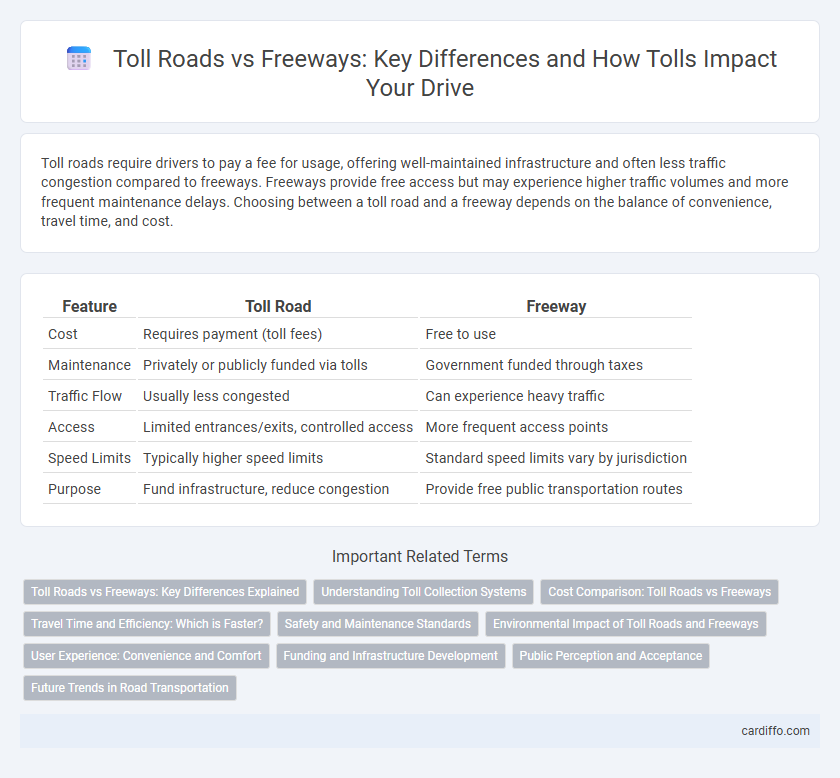Toll roads require drivers to pay a fee for usage, offering well-maintained infrastructure and often less traffic congestion compared to freeways. Freeways provide free access but may experience higher traffic volumes and more frequent maintenance delays. Choosing between a toll road and a freeway depends on the balance of convenience, travel time, and cost.
Table of Comparison
| Feature | Toll Road | Freeway |
|---|---|---|
| Cost | Requires payment (toll fees) | Free to use |
| Maintenance | Privately or publicly funded via tolls | Government funded through taxes |
| Traffic Flow | Usually less congested | Can experience heavy traffic |
| Access | Limited entrances/exits, controlled access | More frequent access points |
| Speed Limits | Typically higher speed limits | Standard speed limits vary by jurisdiction |
| Purpose | Fund infrastructure, reduce congestion | Provide free public transportation routes |
Toll Roads vs Freeways: Key Differences Explained
Toll roads require drivers to pay fees for usage, funding maintenance and infrastructure improvements, while freeways are toll-free and funded primarily through public taxes. Toll roads often feature controlled access and can offer less congestion and better road conditions due to their funding model. Freeways provide unrestricted access without tolls but may experience higher traffic volumes and rely on government budgets for upkeep.
Understanding Toll Collection Systems
Toll roads utilize electronic toll collection systems such as RFID transponders and ANPR cameras to automate payment, reducing congestion and enhancing traffic flow compared to freeways, which are typically funded by taxes and do not require direct user fees. Toll collection methods include barrier toll plazas, open-road tolling, and multilane free-flow systems, each designed to optimize revenue while minimizing disruption to vehicles. Understanding the operational technology behind toll systems is crucial for infrastructure planning and improving driver experience on toll roads.
Cost Comparison: Toll Roads vs Freeways
Toll roads typically require motorists to pay fees based on distance traveled or vehicle type, generating direct revenue for maintenance and infrastructure improvements. Freeways, funded primarily through general taxation such as fuel taxes and vehicle registration fees, do not impose user-specific charges, resulting in indirect cost recovery. The cost comparison reveals toll roads offer more predictable funding with potential for faster upgrades, while freeways provide cost-free access but may face budget constraints and slower maintenance cycles.
Travel Time and Efficiency: Which is Faster?
Toll roads often provide faster travel times than freeways due to less congestion and better-maintained infrastructure, allowing vehicles to maintain higher average speeds. Freeways, while free to use, can experience heavy traffic and frequent stops, reducing overall efficiency. Choosing a toll road can significantly reduce travel duration in urban and high-traffic areas, improving on-time arrivals and fuel efficiency.
Safety and Maintenance Standards
Toll roads often maintain higher safety and maintenance standards due to dedicated funding from toll revenues, enabling regular upkeep, rapid repairs, and advanced traffic management systems. Freeways, funded by general taxes, may experience variable maintenance quality and delayed repairs, affecting roadway safety. Enhanced monitoring systems and well-maintained infrastructure on toll roads contribute to reduced accident rates compared to many freeways.
Environmental Impact of Toll Roads and Freeways
Toll roads often incorporate advanced technologies and materials that reduce environmental degradation compared to traditional freeways, such as improved pavement designs that lower emissions. Freeways typically encourage higher traffic volumes and congestion, which increase air pollution and carbon emissions, negatively impacting surrounding ecosystems. Studies reveal that toll roads, by managing traffic flow through pricing mechanisms, can reduce vehicle idling and greenhouse gas emissions more effectively than freeways.
User Experience: Convenience and Comfort
Toll roads typically offer a smoother driving experience with less congestion due to controlled access and maintained infrastructure, enhancing convenience for travelers. Freeways provide unrestricted access but can suffer from heavy traffic and frequent stops, potentially reducing comfort during peak hours. Users often prioritize toll roads for reliable travel times and reduced stress on longer journeys.
Funding and Infrastructure Development
Toll roads primarily rely on user fees for funding, enabling consistent revenue streams dedicated to maintenance and infrastructure expansion without heavily burdening taxpayers. Freeways, in contrast, are often financed through a combination of federal and state taxes, which can delay construction and improvements due to fluctuating budget allocations. The direct funding model for toll roads promotes faster development and upgrades, enhancing infrastructure quality and responsiveness to traffic demands.
Public Perception and Acceptance
Toll roads often face mixed public perception due to perceived cost burdens compared to freeways, which are typically viewed as accessible and free for all users. While toll roads can improve traffic flow and fund road maintenance through user fees, some drivers resist paying for what they consider a basic public service. Studies show acceptance increases in regions where toll revenue transparency and improved infrastructure quality are clearly communicated to the public.
Future Trends in Road Transportation
Emerging technologies in toll road systems, such as dynamic pricing and automated toll collection, are transforming road transportation by reducing congestion and improving traffic flow compared to traditional freeways. Integration of smart infrastructure with vehicle-to-infrastructure communication enhances real-time data exchange, enabling adaptive traffic management and increased safety. Future trends also include expanding toll road networks to support electric and autonomous vehicles, fostering sustainability and efficiency in transportation.
Toll Road vs Freeway Infographic

 cardiffo.com
cardiffo.com